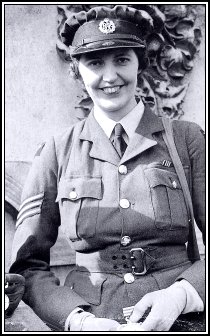The Attack on Kenley and Biggin Hill Aerodromes
August 18th 1940
The raid on Biggin Hill on Sunday August 18 lasted barely ten minutes before it was finally repulsed by the Hurricanes and Spitfires of 32 and 610 Squadrons and the army gunners around the perimeter. The first bombs had fallen to the east, between the airfield and Downe, and had caused little damage. The second raid was more accurate. A Bofors anti-aircraft gun was hit, one of its crew killed and others wounded. The MT sheds were damaged and the airfield was littered with craters and unexploded bombs.
Sergeant (Joan) Elizabeth Mortimer was manning the switchboard in the Armoury and refused to move although she was surrounded by several tons
of high explosive. The bombing became heavier but the WAAF Sergeant ignored the danger and continued to relay vital messages around the defence posts.
As the raiders departed, but before the "All Clear" sounded Sergeant Mortimer walked and ran around the airfield with a bundle of red flags. Where a bomb had not exploded she placed a flag nearby. Biggin Hill was like a minefield and the aircraft, still airborne, needed to know where to land. A bomb exploded nearby, winding her and for awhile she could not walk. When she recovered she continued planting flags. She was ordered to leave the area by an officer who said it was too dangerous. She carried on when he walked away.
 |
For her courage and coolness Elizabeth Mortimer won the Military Medal, one of three to be awarded to WAAFs at Biggin Hill that summer. She had been at the station for almost a year arriving in September 1939 in rather unusual circumstances.
Miss Mortimer had previously worked in the Armoury at Hendon where 601 was based. She heard that the Squadron was to be posted to Biggin Hill and, with her friend Beryl Dobell, was determined to join them. Their colleagues in the Armoury thought there was little hope but the girls were determined to try.
Elizabeth and Beryl asked for a transfer but did not wait for the official confirmation. They drove through the night to the gates of Biggin Hill and when 601 Squadron arrived they calmly accompanied the boys into the station. The CO at Hendon considered them "lost" until she discovered their whereabouts six weeks later!
At Biggin Hill a surprised adjutant politely sent them to find a billet and told them to report back. Believing the adjutant had more important matters on his mind, such as the possibility of war. they stayed out of his way. |
Elizabeth Mortimer, one of the first WAAFS at `The Bump" was also the first to win the MM. Her citation read: This airwoman displayed exceptional courage and coolness which had a great moral effect on all those with whom she came into contact."
There were plenty of heroes on the day that the Luftwaffe bombed Biggin Hill. The young pilots who were sent up to protect their base were outnumbered by five to one but in a "show" that lasted barely 10 minutes the two squadrons bagged at least nine Huns and sent many others fleeing back across the water.
Courtesy Biggin on the Bump © Bob Ogley 1990
|
|
